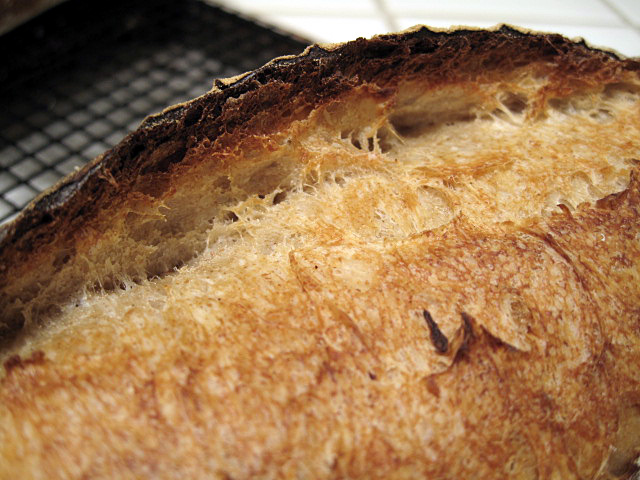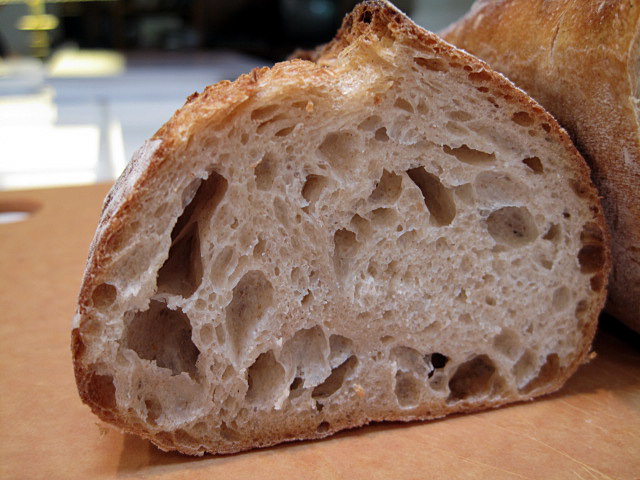The "San Joaquin Sourdough" is my own recipe. It evolved through multiple iterations from Anis Bouabsa's formula for baguettes. Most of my deviations developed in discussion here on TFL with Janedo, who first suggested adding sourdough starter and rye, and, then, leaving out the baker's yeast and making it as a "pure" pain au levain.

I got a pretty nice ear and grigne on this one.

|
Ingredients
|
|
|
Active starter (67% hydration)
|
100 gms
|
|
KAF European Artisan-style flour
|
450 gms
|
|
Giusto's whole rye flour
|
50 gms
|
|
Water
|
370 gms
|
|
Salt
|
10 gms
|
Note: Whole Wheat flour or White Whole Wheat flour may be substituted for the Whole Rye. Each results in a noticeable difference in flavor. All are good, but you may find you prefer one over the others.
Procedures
Mixing
In a large bowl, mix the active starter with the water to dissolve it. Add the flours and stir to form a shaggy mass. Cover tightly and let rest (autolyse) for 30 minutes.
Sprinkle the salt over the dough. Using the plastic scraper, stretch and fold the dough 30 times, rotating the bowl 1/5 turn between each stroke. Cover tightly. Repeat this stretch and fold procedure 3 times more at 30 minute intervals.
Fermentation
After the last series of stretches and folds, scape the dough into a lightly oiled 2 quart/2 liter container and cover tightly. (I use a 2 quart glass measuring pitcher with a tightly fitting plastic lid manufactured by Anchor Glass.) Ferment at room temperature for an hour, then place in the refrigerator and leave it there for 21 hours. (In this time, my dough doubles in volume and is full of bubbles. YMMV.)
Dividing and Shaping
Take the dough out of the refrigerator and scrape it gently onto a lightly floured work surface. Gently pat it into a rectangle. Divide as desired or leave in one piece to make a 980 gm loaf. To pre-shape for a bâtard, fold the near edge up just past the center of the dough and seal the edge by gently pressing the two layers together with the ulnar (little finger) edge of your hand or the heel of your hand, whichever works best for you. Then, bring the far edge of the dough gently just over the sealed edge and seal the new seam as described.
Cover the dough with plastic wrap and/or a kitchen towel and let it rest for 30-60 minutes, with the seams facing up. (The time will depend on ambient temperature and how active your starter is. The dough should have risen slightly, but not much.)
To shape a bâtard, fold the near edge of the dough and seal the edge, as before. Now, take the far edge of the dough and bring it towards you all the way to the work surface and seal the seam with the heel of your hand. Rotate the loaf gently toward you 1/4 turn so the last seam you formed is against the work surface and roll the loaf back and forth, with minimal downward pressure, to further seal the seam. Then, with the palms of both hands resting softly on the loaf, roll it back and forth to shape a bâtard. Start with both hands in the middle of the loaf and move them outward as you roll the loaf, slightly increasing the pressure as you move outward, so the bâtard ends up with the middle highest and the ends pointed .
Preheating the oven
One hour before baking, place a baking stone on the middle rack and both a cast iron skillet (Mine is filled with lava rocks.) and a metal loaf pan (or equivalent receptacles of your choosing) on the bottom shelf. Heat the oven to 500F. Put a kettle of water to boil 10 minutes before baking.
Proofing
After shaping the loaf, transfer it to parchment paper liberally dusted with semolina or a linen couche, liberally dusted with flour. Cover the loaf with plastic wrap and a kitchen towel or a fold of the linen. Proof until the loaf has expanded to about 1-1/2 times it's original size. (30-45 minutes) Do not over-proof, if you want good oven-spring and bloom!
Baking
Put about a cup full of ice cubes in the loaf pan on the bottom shelf of the oven and close the door.
Slip a peel or cookie sheet under the parchment paper holding the loaf or transfer to a peel, if you used a couche. Score the loaf. (For a bâtard, hold the blade at about a 30 degree angle to the surface of the loaf. Make one swift end-to-end cut, about 1/2 inch deep.)
Transfer the loaf and parchment paper to the baking stone, pour one cup of boiling water into the skillet, and close the oven door. Turn the oven down to 460F.
After 12-15 minutes, remove the loaf pan and the skillet from the oven. Rotate the loaf 180 degrees, if it is browning unevenly. Close the oven door.
Bake for another 12-15 minutes, then remove the loaf and place on a cooling rack. Check for doneness. (Nice crust color. Internal temperature of at least 205F. Hollow sound when you thump the bottom of the loaf.) If necessary, return to loaf to the oven to bake longer.
When the loaf is done, leave it on the baking stone with the oven turned off and the door ajar for 5-10 minutes to dry and crisp up the crust.
Cooling
Cool on a rack for two hours before slicing.

Enjoy!
David
Submitted to Wild Yeast Spotting on Wildyeastblog